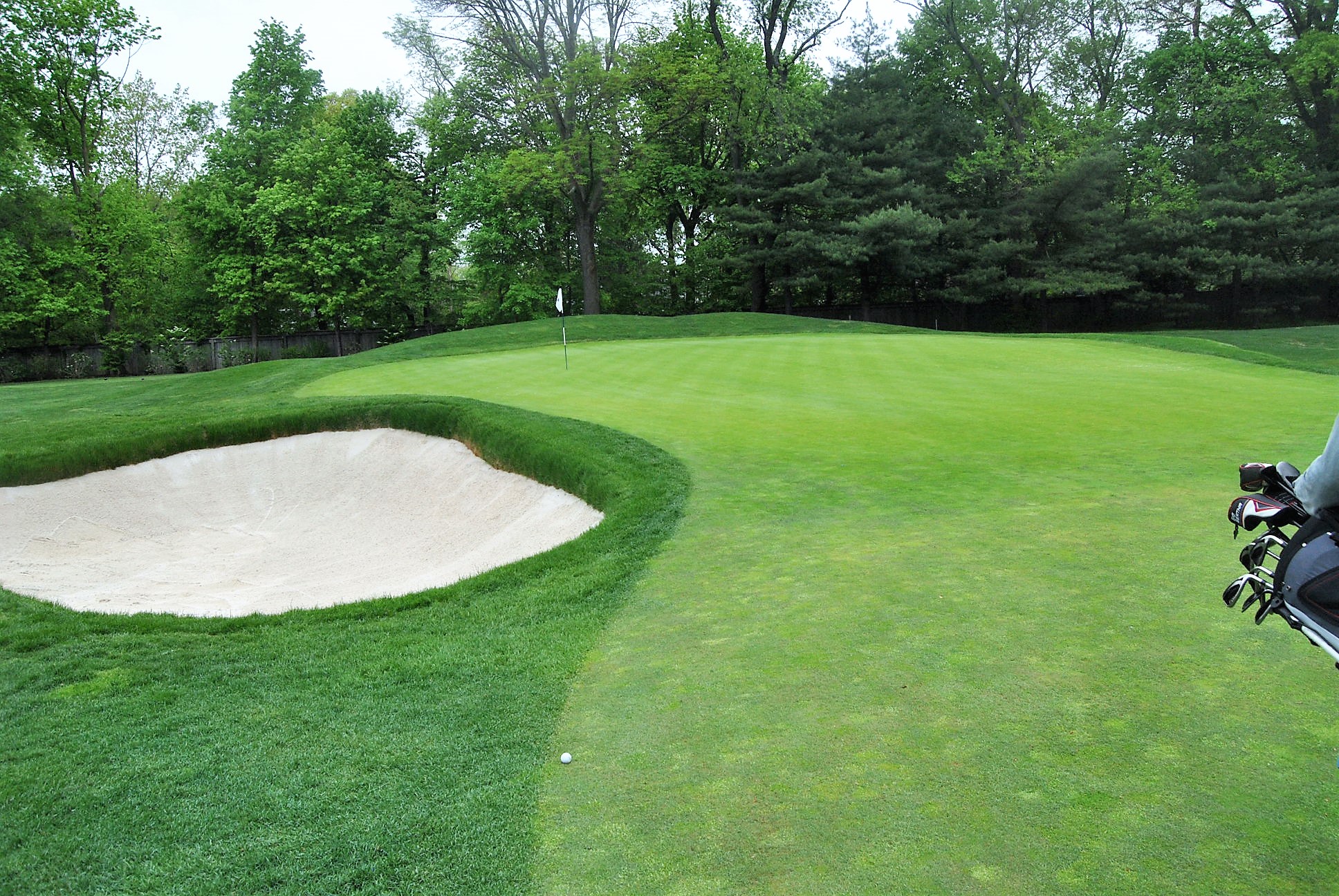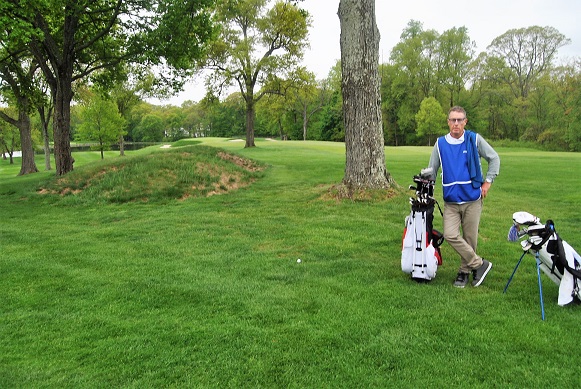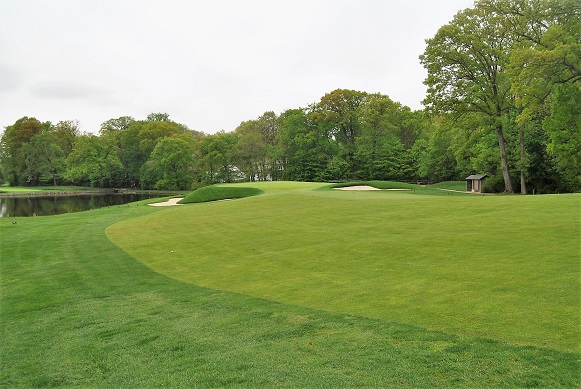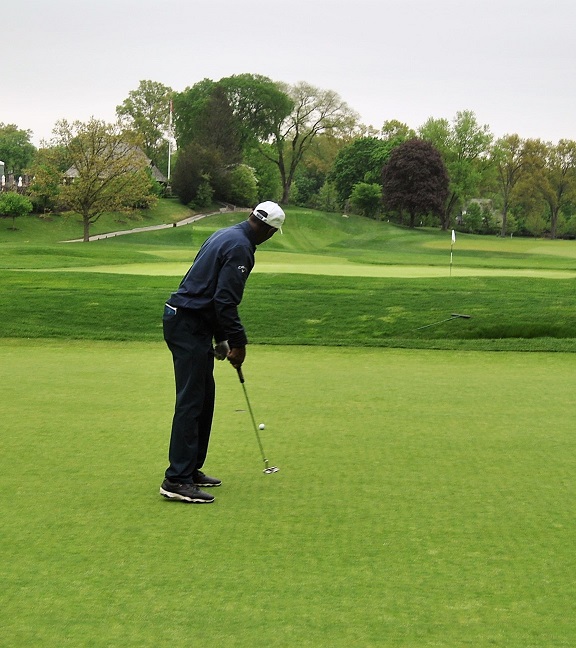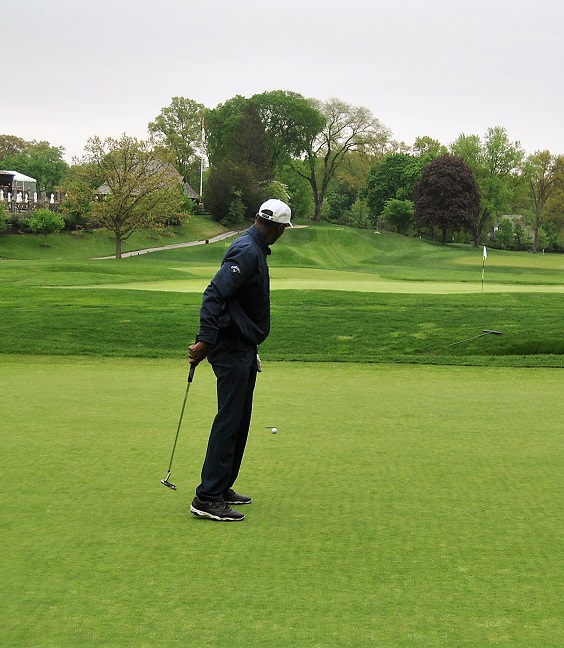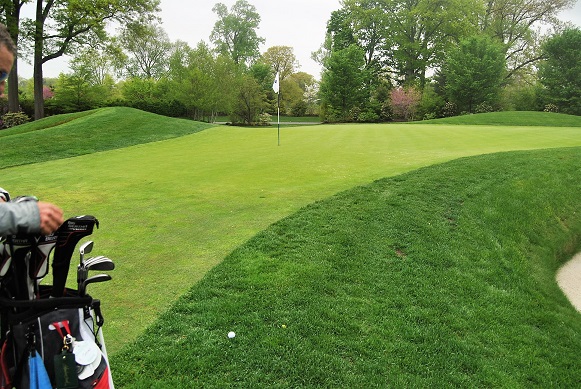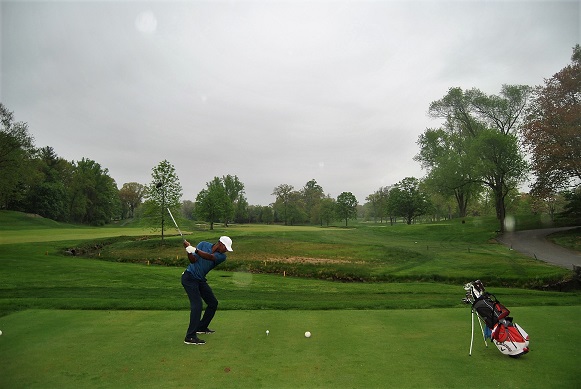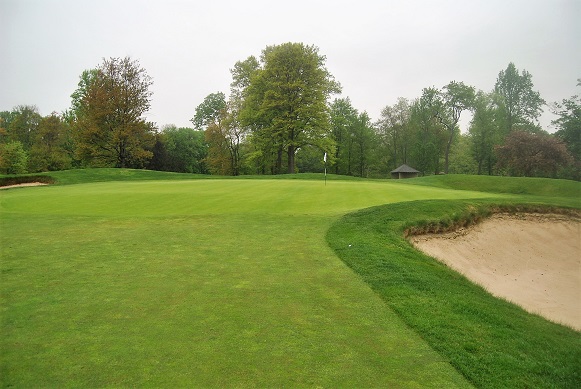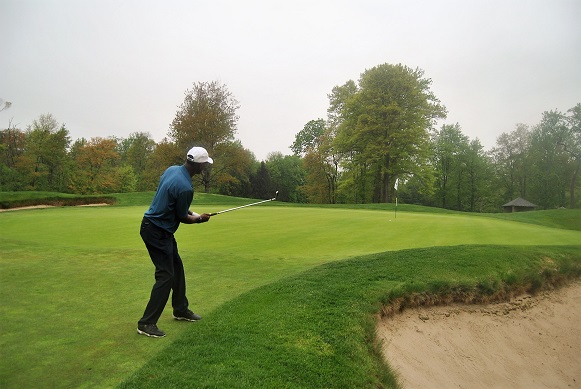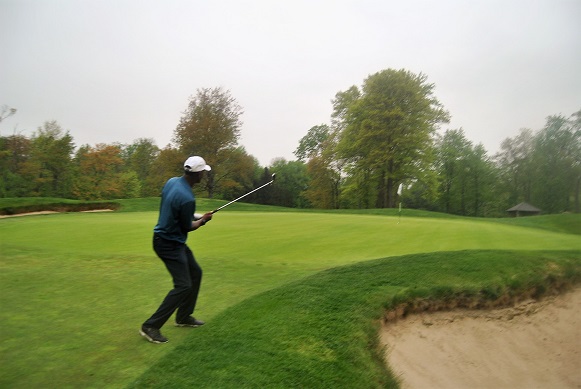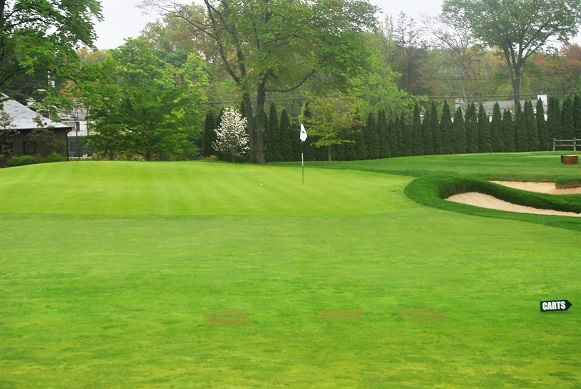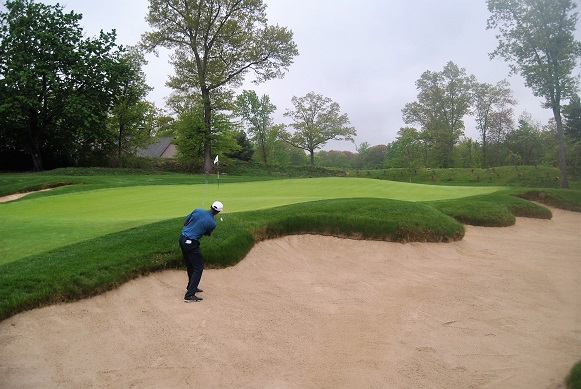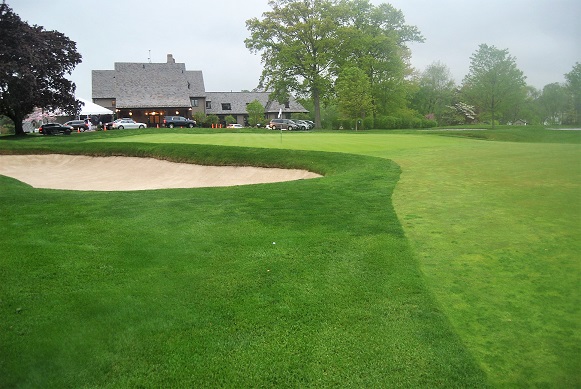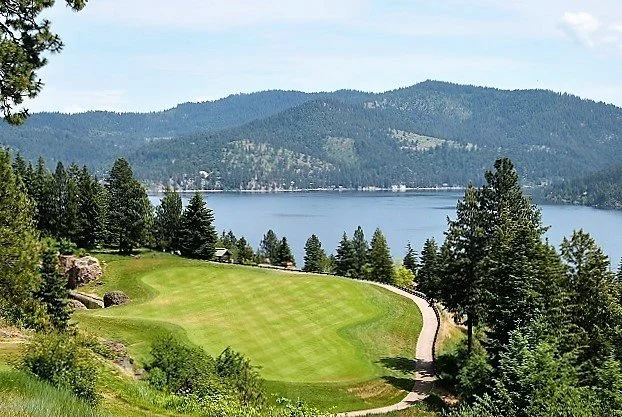The Par 3 Fifth Hole at Quaker Ridge Golf Club
Playing the Golf Digest 2017-18 Top 100 Golf Courses in America in one year requires four primary components – an understanding and supportive significant other, time, connections, and means. On a Tuesday afternoon in late Spring, I discovered that wasn’t enough. I discovered that it also requires fate and a sense of destiny.
After finishing a round on a composite of the East and West Courses at Winged Foot Golf Club in Scarsdale, NY, I told my playing partner, Mike Ballo, and my caddie, Dawnie of Scotland that I was planning to drive to Long Island. They suggested that rather than driving the full route, I drive to New London, Connecticut and take the ferry across Long Island Sound to Port Jefferson. They said it would take about the same time as driving the full route, but it would be more scenic and more relaxing. I didn’t recognize it at the time, but I would later come to understand that their advice was fate intervening in my quest.
The route they suggested put me on the road to destiny. I didn’t realize it when they suggested it, but the route took me right by Quaker Ridge Golf Club. As I drove down Griffen Avenue, the actual names of destiny’s road, I noticed a commotion along the side of the road. There were what looked like a couple of golfers, some members of the Quaker Ridge staff, and one very angry guy all standing near a truck. I turned on to an adjacent street and observed. I assumed that one of the golfers had hit a ball over the stone wall and hit the truck.
I sat in my car and watched until the angry guy moved his truck off the street. It was at that moment I recognized that this had to be fate intervening in my quest. There I was traveling on an unexpected path that takes me by a club that I needed help with and I pass by people who might be able to help. To me this was opportunity calling and I needed to answer the phone. I got out of the car and walked over to the guys who were still standing along the street discussing what I happened. I introduced myself and told them that I believe all things happen for a reason. I told them that whatever unfortunate thing happened that caused them could have a silver lining and that I could be that silver lining. I explained that I was on a quest to play the top 100 courses in the country in one year and that I was running out of year. I explained that I had just 34 days left to play 27 courses. I also explained that I had a host for Quaker Ridge but the timing of when he could host me was a challenge. I explained how I really needed to play the course during the upcoming weekend to have any chance of completing all the courses before my year ended. I told them that I needed their help to do it.
As a teenager, I sold encyclopedias door to door, cold calling on families in the evenings. As a college student I worked evening selling major appliances at Montgomery Wards. During most of my quest I’ve not had to often directly ask for help, most people were thoughtful and kind enough to offer help once I told them what I was doing. I learned while selling encyclopedias and major appliances that sometimes the only way you can close the deal is to ask the customer for the sale. Standing off the side of a street, desperately wanting not to fail, I asked a group of strangers to help me close the deal.
Playing the top 100 courses in a year is not something one person can do alone. It really does take a village. I approached a group of strangers and asked for help. I know this was a bold and extraordinary move, but even when opportunity, you must be willing to take risks to close the deal.
A couple of the guys standing on the side of the road were wearing Quaker Ridge shirts. One of them spoke up and said that the golfers were not members and would not be able to help me, but he said he possibly could. He said that they needed to resolve the situation that they were currently engaged in, but if I’d give him my cell number he would call me later that evening. I gave him my number and continued my journey.
I’ve stated before that life happens at the intersection of aspirations and adversity. When your greatest hopes and dreams come up against your greatest challenges do you pack it in or do you rise up. At the intersection of fate and destiny, I chose to rise up. Later that evening, my phone rang. On the other end was the guy with the Quaker Ridge shirt that I’d given my number to. He introduced himself as Mario Guerra. I recognized that name as the Head Pro for Quaker Ridge.
Mario said that he admired the way I approached them and that he too believes in fate intervening in our lives as a force for good. He asked me to tell him about my background. I told him that I was born into poverty in Texas but overcame a humble beginning to have a great career in the energy industry. I told him that I had retired from that career almost a year ago and was now working to play the top 100 courses in the country in one year.
My story resonated with Mario. It was as if we were two kindred spirits who lives intersected along destiny’s road. Mario informed me that this was peak season at Quaker Ridge and that they don’t normally allow unaccompanied play at the Club on the weekend during peak season. But then he said he admired what I was trying to do and wanted to help. He said that he would speak with the Club’s general manager and the Club President to request an exception. He said he would work on it the next day and get back to me. Even as I write this, my heart still swells with emotion as I recall the gentleness and kindness in his voice. Here was this guy who didn’t know me from Adam, but he took the time out of what had obviously been a long and challenging day to follow-up with a stranger and then offer to help. We are so fortunate that God saw fit to place people like Mario in this world.
The next day Mario called me back with the best of news. He gotten approval for me to play the course with him as his guest on Saturday afternoon. Fate had truly intervened. The pieces of the puzzle were continuing to come together. The journey that I’d begun almost eleven months earlier was starting to have the air of inevitability. I thanked Mario for his kindness and told him I’d see him on Saturday afternoon. Yes, the afternoon of the day that I was originally supposed to play at Shinnecock Hills. Not playing there on that day made it possible to now play at Quaker Ridge. In a strange way, I also felt this meant that somehow playing at Shinnecock would work out too.
I awoke Saturday morning after already having played six courses during the week, to dark clouds looming. The weather forecast was not good. It showed thunderstorms, but I trusted that fate would not be unkind. There had been a chance of rain for every one of the previous six courses and it didn’t materialized. I had to trust that fate was on my side.
I arrived at Quaker Ridge with the dark clouds still looming. With this in mind, Mario and I grabbed our caddie Andrew and headed to the first tee. We decided to have fun and play from the white tees. The white tees measure just 6163 yards with a 70.7 rating and a 134 slope. This would be the shortest distance I’d played on my tour, but not the lowest rating. Quaker Ridge is a tough course regardless of which tees you play.
The first hole of this Tillinghast design nestled in a charming neighborhood in Scarsdale, New York is a 496 yard par five. The narrow tree lined fairway bends slightly from left to right. There is a bunker off the right side at 270 yards from the white tees. I stood on the tee box with my nerves on their ends. After what Mario had done to help me, I really wanted to play well, but I could feel the tension in my body. My heart was racing. My tempo was amped up. I pulled the ball into the left rough.
I hit my second shot out of bounds. I hit my fourth shot to the middle of the fairway. My fifth shot missed the green to the left. I pitched on and two putted to open the round with a triple bogey. While fate had been kind enough to have my life and Mario’s lives intersect, it was not kind to my golf game on this cloudy Saturday afternoon.
The second hole is a 389 yard par four. I’d only seen two holes on this beautiful Quaker Ridge course, but I was already starting to get the picture. This is a course with narrow fairways and tight trees. The second hole sweeps slightly from left to right. There are no bunkers along the second fairway. I somehow even with my nerves still grabbing me and my heart racing, managed to hit a good drive. I hit the ball down the middle leaving 185 yards to the green.
The green plays slightly uphill with bunkers along the left and right sides. The pin was positioned on the back of the green just slightly right of center. I aimed along the left edge of the fairway looking to fade the ball to the pin. I drew the ball instead. It landed left of the bunker.
I pitched on and then three putted for a double bogey. The first two holes at Quaker Ridge are allotted nine strokes. I used fourteen, almost twice as many.
The 414 yard par four third hole is about as straightforward of a hole as you will find on the course. You can see the green from the tee box as your stare down the narrow alley that masquerades as a fairway. There are just two fairway bunkers to contend with. One cuts into the left at 165 yards from the tee. The other is off the right edge at 205 yards off the tee. The trees with their fresh signs of Spring hug the fairway tightly on the right but provide a little more room on the left. That didn’t help me as I pulled my drive into the trees on the left. The ball hit a tree and kicked into the fairway leaving 185 yards to a back left pin position.
The third green is protected by a small bunker on the left and one that runs long the right side. I hit my approach shot to just short of the left front portion of the green.
I pitched to eight feet past and to the right of the flag but missed one of the few opportunities I would have for a par on the front nine when I pulled my putt. I tapped in for a bogey.
The fairway on the 384 yard par four fourth hole has a berm in its right side about 140 yards from the tee. I think it may be A.W. Tillinghast’s way of signaling that this fairway has a lot of undulation. The fairway slopes severely from left to right then back to the left before leveling off just as it approaches the green. I popped my drive up to the left and then punched out of the trees to 102 yards from the pin cut into the middle left portion of the green.
The fourth green has a small bunker off the front right and one that boomerangs from off the front left to the back left. That boomerang bunker helps to prevent errant shots that miss left from going into the first water that comes into play on the course. My third shot hit on the left side of the green and rolled just into the rough.
I chipped on to three feet and made the putt for a bogey.
The picturesque par three fifth hole plays over a pond to oval green that sits at the base of an undulated slope. There are two bunkers that wrap around from the left side to the back and one that runs along the right side. There are only a couple of feet between the front of the green and the edge of the pond. I hit my tee shot to within six feet of the hole.
I now had an opportunity to clean up my score card a little. But alas it was not to be. I missed the birdie putt and tapped in for my first par. That’s a little foreshadowing. It means at some point over the next 14 holes there is at least one more par coming!
The sixth hole is the longest par four on the course from the white tees. It measures 434 yards. The fairway starts out aligned with the tee box and the slides slightly to the left before bending around some trees and back to the right. There is a creek along the left side for the first three hundred yards. The right side of the fairway is lined tightly by the obligatory trees.
A couple of bunkers are cut into the slope on the right side of the fairway at about 200 yards off the tee. Additional bunkers come into play 300 yards off the tee. They are cross bunkers that come in from each side of the fairway and reduce it to a slither. I sliced my drive but got lucky when the ball hit boulder just to the right of the first bunkers on the right and kicked into the fairway.
I laid up with my second shot to just short of the cross bunker on the left.
The fairway opens up past the cross bunkers for the remaining 100 yards to the green. I pulled my third shot into the lone bunker off the right side of the green.
I hit my sand shot nine feet.
I made the putt for a bogey. After opening the round with a triple bogey followed by a double bogey, I was still playing poorly but I had at less momentarily stemmed the tide.
The par four seventh hole is nothing but trouble. It measures 380 yards. It has a creek that crosses in front of the start of the fairway. The creek then bends left to run along the right side of the fairway before bending back to the right to bisect it at 250 yards off the tee. The fairway itself has a left to right dogleg that curves between the trees. I hit my drive to the rough just six feet off the left edge of the fairway.
The second shot on this hole is where the real trouble starts. There are two bunkers off the right side of the fairway just past the creek that cuts across. I assume Mr. Tillinghast put them there to punish the long hitters that would otherwise stick out their chest after carrying the creek. This leaves very little room in the fairway to land drives that carry the creek. I didn’t have to worry about those bunkers since my drive landed well short of the creek leaving about 150 yards to the green.
I did have to worry about the four bunkers near and around the green. The first one is off the left side of the fairway just short of the green. The other three frame the green; one along the left side, one along the right side and one off the back. I pulled my approach shot. The ball landed in the deep rough off the left side of the green just short of the green side bunker. The ball sunk so deep into the rough that it was difficult to find.
I chopped the ball out and onto the green. I then two-putted for another bogey.
The fairway on the short 325 yard par four eighth hole would be generous if not for the big rough covered mound smack dab in the middle of it. The mound is 175 yards off the tie. It is about 60 yards long and half that wide. With this mound, Mr. Tillinghast forces you either not take advantage of the short hole and lay up well short of the green, try to hit the narrow strip of fairway on either side of the mound and have a wedge to the green, or to still hit your driver to carry the mound and be left with a pitch shot to the green. Did I mention earlier that you shouldn’t let the length of the course lull you into a face sense of easiness? I chose the driver option and immediately popped my drive up to the left. The ball landed just off the fairway leaving about 180 yards to the flag.
The small uphill eighth green has an even smaller front and is protected by bunkers on the left and the right. My approach shot landed in the right rough just off the front of the right side of the green. I chipped on and one putted for only my second par of the round.
I closed out the front nine with a double bogey on the 134 yard par three ninth hole. The hole is straight forward but the green is infected with bunkers. There are five protecting it. I pull my tee shot into one off the left side of the green.
I hit my sand shot onto the green, but the ball rolled into the bunker on the right side of the green. My sand shot from that bunker stayed on the green, but a good distance from the flag. I two-putted from there for my double bogey and a front nine score of a lofty 46.
As we were putting out on the ninth green, light rain began to fall. Mario needed to ensure he didn’t put himself at rise of getting sick with a busy couple of weeks ahead. He decided that he’d stop after 9 holes. I continued to the back nine with Drew.
I thought that my play would get better without the pressure of playing with the Head Pro. My first tee shot on the back nine seemed to confirm that. The tenth hole is a 172 yard par three. There is a creek that crosses between the tee boxes and an apron off the front of the green. Like the par three ninth hole, the green is protected by several bunkers. There are two off the front, two off the left side and two off the right side. I struck the ball flush on my tee shot. The ball flew over the flag and rolled to 25 feet past.
Unfortunately, my putting stroke didn’t get the memo on me playing the back nine better than I played the front nine. I three-putted from 25 feet to make a bogey on the hole.
The eleventh hole at Quaker Ridge is a 360 yard par four. The tee box is shifted to the left of the start of the fairway. A creek crosses just off the front of the tee box and turns right to run along the left side of the fairway. There are trees on the left that are very close to the edge of the fairway and three bunkers on the right starting at about 240 yards off the tee. I hit my drive to the right rough about 10 yards short of the start of the bunkers.
The approach shot to the green is filled with peril. The fairway narrows significantly from about 75 yards in. The creek running along the left side of the fairway turns right and cuts across the front of the green before bending left to run along the right side of the green. There is a bunker off the left side of the green and another off the back.
I hit my approach shot along the right edge of the left front bunker expecting the ball to fade toward the middle right pin. I hit too far behind the ball and hit is straight rather than with a left to right spin. The ball landed to the left of the creek that runs along the left side of the fairway.
I pitched onto the green to 25 feet past the flag. I missed my par putt by a couple of inches and settled for another bogey.
The twelfth hole is a beautiful 377 yard four that cuts straight through the trees toward a slightly uphill green. That babbling and ever-present creek crosses the 12th hole just short of the start of the fairway. The fairway takes an almost direct path to the green but curves around a bunker off its right side at about 200 yards from the white tees and another one on the left side at about 75 yards from the green. I hit my drive down the right side of the fairway to just left of the right fairway bunker.
The 12th green has a small bunker off the front right and a large one along the left side. There is also a pot bunker off the back right. I hit may approach shot to just short of the green and just to the right of the front right bunker.
My chip shot to the back-right pin tracked toward the hole all the way. The ball road the right edge of the hole and rolled to five feet past.
My par putt caught the inside of the cup and spun out. I tapped in for my third bogey in a row on the back nine.
The thirteenth hole is the last the of the par threes on the course. It is also the longest, the most challenging and most scenic. The trees on the left and right form a nice alley to a green that is framed by a grove of trees. The green slopes up from front to back and is protected by a classic Tillinghast bunker that is well short of it but looks like its off the front left edge and another bunker along the right side. I hit way behind the ball on my tee shot. The ball landed well short of the green.
I pitch shot was right at the flag. The ball rolled six feet past.
For the fourth consecutive hole I missed a makeable par putt and made a bogey on the hole.
The 499 yard par five fourteenth hole is probably the most bunkered hole on the course. There are several clustered together off the left side of the fairway starting at 200 yards off the tee. There is another cluster that fills the space between the first part of the fairway and the second part of the fairway at about 150 yards from the green. There are additional bunkers off the left side of the fairway -one large one at the start of the fairway and several leading up to the green. I hit my drive to the right side of the fairway. The ball rolled into the rough to the left of the first fairway bunker.
I shanked my second shot into the trees on the right and then hit my third shot across the fairway into the trees on the left.
I hit my fourth shot back to the middle of the fairway but well short of the green, 63 yards from the pin to be exact.
I pitched onto the green with my fifth shot to about 5 feet left of the hole.
I finally made a putt, but it was to save bogey rather than par.
The fifteenth hole at Quaker Ridge is a testy little par four. The hole measures 368 yards and has a very narrow fairway that is bisected by my favorite creek that just keeps meandering through the course. It crosses the fairway at about 75 yards from the front of the green. I hit a three wood off the tee down the middle of the fairway leaving 180 yards to the middle left pin.
The middle left pin is probably the easiest pin placement past the front of the green. The rest of the green is very undulated making placement of your approach shot very critical. I tried to draw my approach shot to the pin but failed. The ball faded slightly and landed just short of the green on the right before kicking into the bunker to the right of the green.
I hit my bunker shot to 20 feet left and below the flag.
I missed another par putt and tapped in for my sixth consecutive bogey on the back nine.
By the sixteenth hole, the misty rain that started on the ninth hole had gotten a little more intense. That coupled with my inability to make a par motivated me to hasten the completion of the round. I was enjoying the course and hearing golf stories from Drew. He was steep in golf knowledge and history. Nevertheless on this dreary Saturday afternoon, I was ready for my round to come to an end.
On the 392 yard par four sixteenth hole with a fairway that seems wider than it is because the trees are not hugging the edge, I hit another drive landed in the fairway but that kicked just off and into the rough. The ball came to rest just short of the first of two bunkers off the right side leaving just over 170 yards to the middle of the green. A green with bunkers on the left, the right and off the back. A green that I noticed was the exact same depth as most of the previous one on the back nine. Most have a depth of 33 yards. The pin was on the back of the green adding 15 more yards to my approach shot.
I hit my approach shot off the right side of the green. The ball landed in the bunker. It was just one of those days. I was now striking the ball much better than I had on the front nine but couldn’t get my approach shots onto the green.
I hit my sand shot to 15 feet below the hole.
On que my par putt slide by the hole. I made my seventh straight bogey. The good news is that I had just two more holes to complete my round. I probably must admit that seven courses in five days is probably a bit much for even a road warrior like me. I was on a beautiful well-maintained course, yet I was looking forward to getting that last putt to the bottom of the cup on the 18th hole.
The penultimate hole at Quaker Ridge Golf Club is a short par four of only 336 yards. It’s a hole with none of the tomfoolery you sometimes fine on short par fours. It is the third easiest hole on the course. The fairway shifts from right to left off the tee and then bends around two bunkers off the right side of the fairway at about 220 yards off the tee. You would think that certainly everyone could make a par on this the easiest of all par fours on the course. That is unless you make a mess of the hole like I did.
I popped my drive up to the left, hit my second shot into the one of the bunkers off the left side of the fairway, hit my third shot back to the fairway, hit my fourth shot into one of the four greenside bunkers, hit my fifth shot onto the green and then one-putted for a double bogey. My string of bogeys had come to an end but not in the way I wanted it to.
I was on a dream course having a nightmare of a round. The good news is that Drew is a saint. In the mist of such bad golf, he hung in there on every painful shot. I must tip my hat to him for sticking out with me. As we approached the 18th tee box Drew was just as enthusiastic and positive as he was on the first tee. He is passionate about golf, every aspect of golf. I was very fortunate to have him on my bag on this misty Saturday afternoon.
The final hole at Quaker Ridge has one of the narrowest fairways on the course. It is an intimidating experience to stand on the 18th tee box and stare out at the alley that frames the fairway. There are no bunkers to worry about. There is just a narrow fairway, trees and deep rough. I thought about teeing off with my three wood to increase the odds of hitting the fairway, but decided the hole was just too long to do that. I decided to go with my driver. It was a mistake. I hit my drive to the left rough.
I topped my second shot. The ball stayed in the rough. I hit my third shot to just short of a bunker off the left front of the green.
I pitched my fourth shot over the bunker to just below the flag. I made the putt to bring my disastrous round to an unceremonious end. Not withstanding the poor ball striking on the 17th and 18 holes, I struck the ball better on the back nine than I did on the front nine, but still couldn’t get the ball into the cup. I didn’t make a single par on the back nine and only made two on the front nine. I shot a 45 on the back nine for a total score of 91, but if felt like I shot a 100. It’s a par 70 course so it was 21 strokes over par making it my worse round since the 95 I shot at Cypress Point.
Following my round, I went back to the starters shack with Drew. He wanted me to meet Chris Calvert who I think is the caddie master. Drew wanted me to meet Chris so that I’d have him as a contact in case I needed help with any of the final courses. After I told them I was playing at the Country Club of Brookline during the upcoming week, they asked me to say hello to Sara Dickson for them. Sara had been an assistant pro at Quaker Ridge.
After my discussions with Drew and Chris, I headed to my hotel and looked forward to a day off. Sunday would be a travel day as I prepared for another intense week of golf with just 30 days to play the remaining 23 courses. All of which were firmly scheduled except for Shinnecock Hills, Aronimink, and Pine Valley. I had leads on all three but no firm dates. I’d like to thank Mario for helping me with Quaker Ridge. It left me with a little more flexibility on dates for those three courses that were not yet scheduled and reaffirmed that I was destined to complete the challenge of playing all 100 courses by my June 11th deadline.






